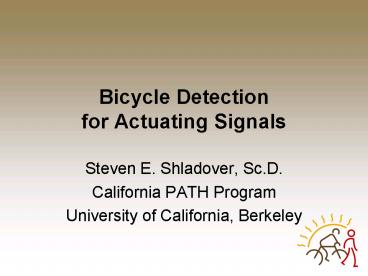Bicycle Detection for Actuating Signals PowerPoint PPT Presentation
1 / 18
Title: Bicycle Detection for Actuating Signals
1
Bicycle Detection for Actuating Signals
- Steven E. Shladover, Sc.D.
- California PATH Program
- University of California, Berkeley
2
Project Goals
- Identify and/or develop technological capability
for reliably detecting bicyclists stopped at an
actuated traffic signal - Use the bicyclist detection to trigger the green
phase - Discriminate bicyclist from motor vehicle to
adjust green phase length to give bicyclist
sufficient time to cross or turn
3
Literature on Bicyclist Speed and Acceleration
- Original data in Taylor study (Austin, TX) from
1993 - Most recent data in Rubins and Handy from U.C.
Davis, 2005, reproduced here - 10 intersections
- 11 hr of video data
- Predominantly young adult riders
- Speed range from 2.9 33 ft/s (2 22 mph)
- 95 within 3.8 23.1 ft/s (2.6 15.8 mph)
- Mean speed 13.46 ft/s (9 mph), standard deviation
4.83 ft/s (3.3 mph)
4
Distribution of Observed Bicyclist Speeds (Rubins
and Handy)
Mean speed
5
Bicyclist Crossing Times (all) from Rubins and
Handy
6
Literature on Bicyclist Detection
- Caltrans bicycle video detection demonstration
- Kimley-Horn for Caltrans District 4, 2004 - MinnDOT Bicycle and Pedestrian Detection report
2003 - UNC Pedestrian and Bicycle Data Collection in
U.S. Communities (Schneider, et al, 2005) - U. Mass technology evaluation (2001-2006)
7
Detection Technology Findings (1/3)
- Video image processing
- Univ. of Minnesota in 1999-2000
- Counting bicyclists, up to 2 per image
- 70 accuracy, 8 frames/s
- Laboratory prototype only
- Kimley-Horn study for Caltrans, 2004
- 4 COTS image processors tested under ideal
conditions (fine-tuned by vendors, good weather),
Iteris preferred - High detection percentages (up to 98)
- No discrimination between bicyclists and motor
vehicles
8
Detection Technology Findings (2/3)
- Inductive loops
- Type D loop sensitive enough if bicycle is on top
of it, but doesnt discriminate bicycle from
motor vehicle - ZELT loop from EcoCounter in France discriminates
bicycles in motion (gt4 mph) from motor vehicles,
but not when stopped, and must be gt4 m away from
any loops in adjacent lanes
9
Detection Technology Findings (3/3)
- Laser scanners
- IBEO 270-degree horizontal scanner for automotive
applications - High cost (50 K, may come down to 10 K)
- Needs to scan plane parallel to ground,
vulnerable to occlusions - OSI AutoSense (formerly Schwartz Electro-Optics)
- Overhead mounting, scanning in vertical planes
parallel to lane centerline - Tested by U Mass, showing 92 success rate with
enhanced classification algorithms
10
Testing Enhancements to COTS Products
- Installed video and OSI detectors at RFS test
intersection - Video image processing intelligence to
discriminate bicyclist shapes from motor vehicles - Later Possibly enhancing OSI AutoSense
discrimination of motorcycles/bicyclists from
vehicles
11
RFS Intelligent Intersection - Sensor Diagram
12
(No Transcript)
13
OSI Laser Scanner
Weight 25 lbs Cost 7300
14
BULLET Color Outdoor Camera
Weight 6.5 oz Cost 60 Needs image processing
computer
15
Video Detection at RFS Site
16
Video Detection in Urban Setting
17
Challenges with Shadows
Find all the bicyclists in the pictures!
18
Next Steps
- Multiple sensors may be needed to ensure reliable
detection under all conditions - No specific requirements for detection
reliability - Combine video with OSI laser scanner
- Related simulation work to assess impacts of
extended green on mainline traffic - Public field test if results look sufficiently
promising

